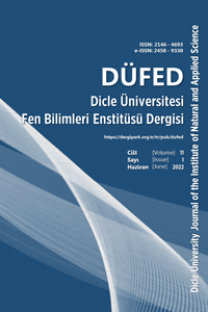Mimarlık Öğrencilerinin Enerji Verimli Binalar Hakkında Farkındalık ve İhtiyaçları Üzerine Bir Araştırma
Research on Awareness and Needs of Architecture Students About Energy Efficient Buildings
Energy efficient building Architecture, Education, Design,
___
- K. Song, S. Qu, M. Taiebat, S. Liang, and M. Xu, “Scale, distribution and variations of global greenhouse gas emissions driven by U.S. households,” Environ. Int., 133, (2019) 105-137.
- A. Ferreira, M. D. Pinheiro, J. de Brito, and R. Mateus, “Relating carbon and energy intensity of best-performing retailers with policy, strategy and building practice,” Energy Effic., 13, (2020), 597-619.
- Ministry of Energy and Natural Resources, “National Energy Efficiency Action Plan 2017-2023”, Ankara, (2018).
- “Scopus preview - Scopus - Welcome to Scopus.” [Online]. Available: https://www.scopus.com/home.uri. [Accessed: 08-May-2020].
- A. Hinge, “Zero Energy Building Definitions and Policy Activity,” (2018).
- A. Chel and G. Kaushik, “Renewable energy technologies for sustainable development of energy efficient building,” Alexandria Eng. J., 57(2), (2018), 655–669.
- A. Gusev, “Comparison of Energy Efficiency Measures in Russia to those Implemented by Developed Countries (Including IEA Measures),” (2014).
- A. Stephan, R. H. Crawford, and K. de Myttenaere, “A comprehensive assessment of the life cycle energy demand of passive houses,” Appl. Energy, 112, (2013), 23–34.
- T. Çivici, “İnşaat Proje Organizasyonlarında Kişiler Arası Çatışma Çözüm Yaklaşımları ile Kişilik Özellikleri Arasındaki İlişki,” Çukurova Üniversitesi Mühendislik-Mimarlık Fakültesi Derg., 34(3), (2019), 195–206.
- N. L. Eleni Antonara, J. Georgi, “Sustainable architecture through an environmental educational program,” in 4th International Conference on Renewable Energy Sources and Energy Efficiency – New Challenges, at Nicosia Cyprus, 2013.
- S. S. Uzunoglu and K. Uzunoglu, “The application of formal perception of gestalt in architectural education,” in Procedia - Social and Behavioral Sciences, (2011), 993–1003.
- M. Ryghaug and K. H. Sørensen, “How energy efficiency fails in the building industry,” Energy Policy, 37(3), (2009), 984–991.
- M. Ghonim and N. Eweda, “Investigating elective courses in architectural education,” Front. Archit. Res., 7(2), (2018), 235–256.
- S. Altomonte, “Environmental education for sustainable architecture,” Rev. Eur. Stud., 1(2), (2009), 12–21.
- S. Holdsworth and O. Sandri, “Sustainability Education and the Built Environment: Experiences from the Classroom,” J. Educ. Built Environ., 9(1), (2014) 48–68.
- Y. Karatepe, S. V. Neşe, A. Keçebaş, and M. Yumurtaci, “The levels of awareness about the renewable energy sources of university students in Turkey,” Renew. Energy, 44, (2012), 174–179.
- M. A. Ismail, N. Keumala, and R. M. Dabdoob, “Review on integrating sustainability knowledge into architectural education: Practice in the UK and the USA,” Journal of Cleaner Production, 3, (2017), 1542-1552.
- M. W. Ellis and E. H. Mathews, “A new simplified thermal design tool for architects,” Build. Environ., 36(9), (2001), 1009–1021.
- A. N. Çalıkuşu, “Sustainability in architectural education: The impact of education on perceptions of sustainability,” Middle East Technical University, (2019), METU, FBE, Ankara.
- P. Boarin, A. Martinez-Molina, and I. Juan-Ferruses, “Understanding students’ perception of sustainability in architecture education: A comparison among universities in three different continents,” J. Clean. Prod., 248, (2020), 1-16.
- S. Porras Álvarez, K. Lee, J. Park, and S.-Y. Rieh, “A Comparative Study on Sustainability in Architectural Education in Asia—With a Focus on Professional Degree Curricula,” Sustainability, 8(3), (2016), 1-32.
- M. Dabaieh, M. Lashin, and A. Elbably, “Going green in architectural education: An urban living lab experiment for a graduation green design studio in Saint Catherine, Egypt,” Sol. Energy, 144, (2017), 356–366.
- K. Yeang, Ecodesign: A Manual for Ecological Design. Wiley, (2008).
- S. Ceylan, “A model proposal for integrating energy efficienct/sustainable design principles with architectural education in Turkey,” Yildiz Technical University, 2016.
- S. Tönük, K.S. Kayıhan, “Sürdürülebilir Temel Eğitim Binasi Tasarimi Bağlaminda Arsa Seçimi Ve Analizi Konusunun İrdelenmesi,” Yıldız Tech. Univ. Fac. Archit. E-Journal, 3(2): (2008), 137–154.
- R. Baeumle and G. R. Hunt, “Capturing the needs of architects: a survey of their current information requirements for natural ventilation design,” Int. J. Vent., 17(2), (2018), 120–147.
- C. de Gaulmyn and K. Dupre, “Teaching sustainable design in architecture education: Critical review of Easy Approach for Sustainable and Environmental Design (EASED),” Front. Archit. Res., 8(2), (2019), 238–260.
- L. Mavromatidis, “Coupling architectural synthesis to applied thermal engineering, constructal thermodynamics and fractal analysis: An original pedagogic method to incorporate ‘sustainability’ into architectural education during the initial conceptual stages,” Sustain. Cities Soc., 39, (2018), 689–707.
- Z Inna., L. Movchan, “The Role of Elective Courses in Students′ Professional Development: Foreign Experience,” Comp. Prof. Pedagog., 7, (2012), 20–26.
- M. R. Hedges, G. A. Pacheco, and D. J. Webber, “What determines students’ choices of elective modules?,” Int. Rev. Econ. Educ., 17, (2014), 39–54.
- D. H. Ting and C. Lee, “Understanding students’ choice of electives and its implications,” Stud. High. Educ., 37(3), (2012), 309–325.
- K. Keskin and M. Erbay, “A Study on the Sustainable Architectural Characteristics of Traditional Anatolian Houses and Current Building Design Precepts,” Procedia - Soc. Behav. Sci., 216, (2016), 810–817.
- K. Gunce, Z. Erturk, and S. Erturk, “Visual Interpretation of Architectural Form,” in Proc. 5th Int. Postgraduate Res. Conf. İn the Built and Human Environment, Salfort, 2005, pp. 385-392.
- ISSN: 2146-4693
- Yayın Aralığı: Yılda 2 Sayı
- Başlangıç: 2012
- Yayıncı: Dicle Üniversitesi
Aroclor 1254’e Maruz Kalan Elastinin Yapısında Meydana Gelen Değişikliklerin İncelenmesi
Özlem DEMİRCİ, Pelin UĞURLU, Nurcan DOĞAN, Ömer ACER, Ersin KILINÇ
Yusuf YILDIZ, Semiha KARTAL, Türkan GÖKSAL ÖZBALTA
Abdulmuttalip MEŞE, Erdem GÜLÜMSER
Kaba Yem Üretimi ve İhtiyacı Yönünden Kahramanmaraş İlinin Genel Durumu
Ömer Süha USLU, Mustafa KIZILSIMSEK, Furkan BALCI
Uçucu Yağların Dizel Motorlarda Yakıt Olarak Kullanılabilirliğinin Araştırılması
Cengiz ATİŞ, Omeed Adwal Ali ALİ, Uğur DURAK, Serhan İLKENTAPAR, Okan KARAHAN
